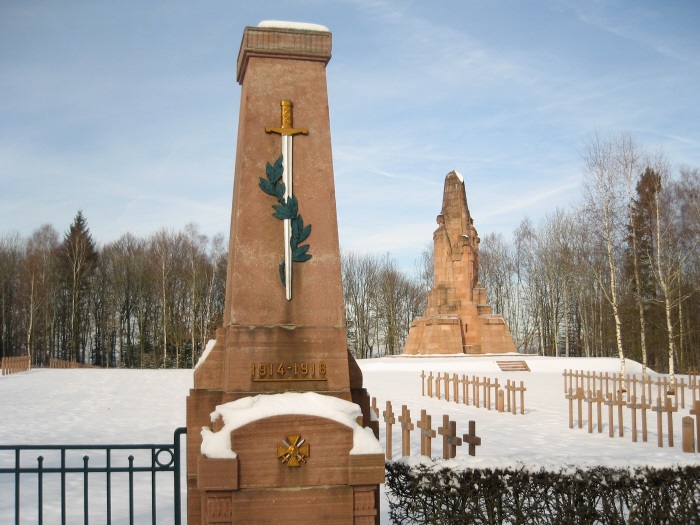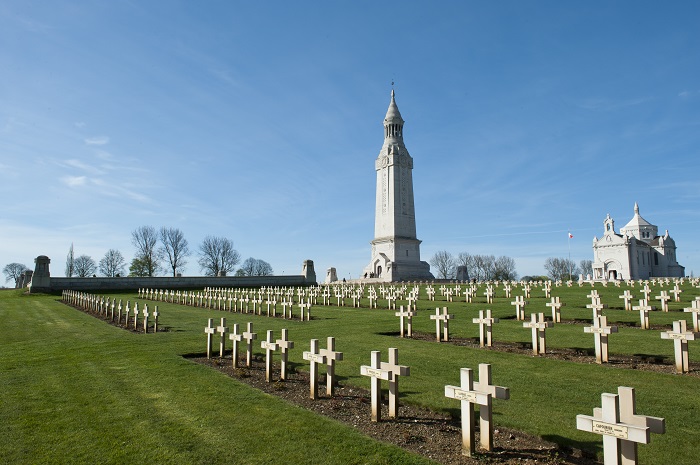The cemeteries

La Fontenelle Cemetery. © ECPAD
The preservation of war graves under the responsibility of the Ministry of the Armed Forces:
national cemeteries, military burial plots in metropolitan France and overseas military cemeteries
One of the basic functions of the State is to preserve the graves of soldiers who “died for France”.
For a long time, soldiers killed on the battlefield were buried in mass graves. At the end of the 19th century, that practice changed. The Franco-German Treaty of Frankfurt (1871) stipulated that the former belligerents undertook to maintain the graves of soldiers buried on their respective territories. Then, in 1915, it was enshrined in law that soldiers who “died for France” should be buried in individual graves, maintained in perpetuity by the State/Ministry of the Armed Forces. Accordingly, when the First World War came to an end, in France and overseas, military cemeteries and burial plots in local cemeteries were created, in which to bury the remains of soldiers who “died for France”.
In France, the terms sépultures militaires perpétuelles (“perpetual military graves”) or sépultures de guerre (“war graves”) refer to all graves containing service personnel who died for France in war and whose bodies were not returned to their families.
National cemeteries and military burial plots
In metropolitan France, the Ministry of the Armed Forces is responsible for 275 national cemeteries (including seven foreign cemeteries) containing nearly 750 000 bodies, and nearly 2 200 military burial plots in local cemeteries, containing 115 000 war graves.

Cemetery of Notre Dame de Lorette. © ECPAD
88% of those bodies are of soldiers from the First World War. Notre Dame de Lorette (Pas-de-Calais) is the largest military cemetery in France: 25 hectares, 20 058 bodies in graves and 20 000 in ossuaries. It is followed by Fleury-devant-Douaumont (14 hectares, 16 000 bodies).
The departments of Meuse, Marne, Aisne, Somme, Meurthe-et-Moselle and Moselle have the most military cemeteries (20 to 40 sites). Haut-Rhin, Bas-Rhin, Vosges and Oise each have more than ten.
In the absence of conventions with the countries concerned, the Directorate for Heritage, Remembrance and Archives (DPMA) maintains, free of charge, seven foreign military cemeteries in France: one Russian cemetery in Saint-Hilaire-le-Grand (Marne), two former Soviet cemeteries in Valleroy (Meurthe-et-Moselle) and Noyers-Saint-Martin (Oise), one Polish in Urville-Langannerie (Calvados), one Czechoslovakian in Neuville-Saint-Vaast (Pas-de-Calais), one Dutch in Orry-la-Ville (Oise) and one Romanian in Soultzmatt (Haut-Rhin).
It also maintains various burial sites of soldiers killed in combat in the conflicts that preceded the First World War, namely the Crimean War and the Franco-Prussian War (1870-71).
French overseas military cemeteries
The Ministry of the Armed Forces is also responsible for the graves of French service personnel overseas, or a thousand burial sites in nearly 80 countries, where 230 000 bodies are buried. The graves are linked mainly to contemporary conflicts: the Franco-Prussian War, the First and Second World Wars, the First Indochina War, the wars in North Africa and, more recently, servicemen and women killed in overseas operations. But they also include 19th-century conflicts like the Napoleonic Wars and the Crimean War, in which France took part. The Ministry of the Armed Forces also preserves the graves of service personnel killed other than in war service, known as tombes de garnison, or “garrison graves”. These graves are located, for the most part, in overseas departments and collectivities, as well as former French colonies.
See some of the sites
With the exception of Algeria and Morocco, where the task is carried out by ONAC-VG, it is the French diplomatic posts or armed forces higher commands that are responsible for the upkeep of these graves, on behalf of the ministry, in over 50 countries. In other countries, the burial sites are maintained by governments, local authorities or local organisations. In these cases, the Ministry of the Armed Forces monitors the process through the French diplomatic posts.
Unprecedented preservation programmes to incorporate these sites in remembrance tourism
At the time of the First World War centenary, military cemeteries and burial sites were the focus of everyone’s attention. Indeed, French people discovered a genuine interest in remembrance tourism, which saw outstanding growth that has kept up momentum today. Aware of the value of these cemeteries in terms of remembrance and tourism heritage, visitors expect them to be treated with the respect the State owes to those who died for France.
In this context, the Ministry of the Armed Forces/DPMA, in partnership with its operators, set out plans for an ambitious restoration policy for the remembrance sites under its responsibility. Between 2011 and 2019, nearly 20% of cemeteries were restored and key large-scale works were carried out on overseas sites. For the period 2020-2025, it was decided that the process of restoration of the sites should continue, as there is still much work to be done, particularly in France. Priority is given to respecting the authenticity of the sites and improving visitor welcome, in particular by prioritising site safety.
Florent Cemetery in Argonne. © Guillaume Pichard
With the same aims as traditional cemetery preservation, the Ministry of the Armed Forces, mindful of the challenges of sustainable development and conserving biodiversity, has implemented, in conjunction with ONAC-VG, alternative, environmentally friendly methods of upkeep. The implementation on 1 January 2017 of the Labbé Act (introducing methods of upkeep in accordance with the Law of 2015 on the energy transition for green growth) has meant interventions are required on all sites. With the support of State-approved landscape designers and architects, the DPMA has produced a landscaping style guide for the development and restoration of military cemeteries. The guide aims to make the sites more attractive through improvements to information, building and landscape design, in order to create “remembrance parks”, sites of exemplary environmental and heritage value that are in keeping with their remembrance setting and could be incorporated into existing remembrance tourism trails.
Promotion of the sites is geared to the commemorative calendar and involves the organisation of a wide variety of events on site, including ceremonies, educational activities, exhibitions and talks.
Pas de l’Aiguille Cemetery. © Guillaume Pichard
In 2014, the DPMA launched a programme for the replacement of the historical information panels in the cemeteries. The programme took four years to complete (2014-2018), equipping all 275 cemeteries. A new phase of the programme is underway in the period 2019-2023 for the main local military burial plots. For the period 2020-2025, the priority actions involving the cemeteries are linked to the 150th anniversary of the Franco-Prussian War (2020-21) and the 80th anniversary of the Second World War (2019-25). However, the health crisis has led to the postponement or cancellation of a number of ceremonies. The experiences of partnerships with schools and actions with young offenders in conjunction with the departmental authorities, for the landscaping or upkeep of the sites, are set to become widespread as a means of strengthening the bond between the armed forces and the nation. Lastly, the DPMA wants to encourage actions aimed at better incorporating the cemeteries in remembrance tourism, by launching a consultation in 2021 on improvements to road signs and the production of tourist leaflets about the cemeteries.
Inscription des « Sites funéraires et mémoriels de la Première Guerre mondiale, front ouest » au patrimoine mondial
Le 20 septembre 2023, 139 sites funéraires et mémoriels de la Première Guerre mondiale répartis en France et en Belgique ont été inscrits au patrimoine mondial lors de la 45ème session du comité du patrimoine mondial, qui s’est tenue à Riyad (Royaume d’Arabie Saoudite).
Cette reconnaissance vient saluer plus de 10 ans d’efforts portés par les gouvernements de la Flandre et la Wallonie et de l’Association « Paysages et sites de mémoire de la Grande Guerre » (APSMGG) qui a réuni les départements, l’État, les collectivités, les associations et les principaux gestionnaires de sites.
Elle est également le fruit d’une mobilisation sans faille des pays qui ont soutenu ce dossier lors des différentes cessions du comité du patrimoine mondial.
Pour la France, 96 des 139 sites retenus sur la liste se situent dans trois régions françaises (Hauts-de-France, Ile-de-France et Grand Est). 43 se situent en Belgique (Flandre et Wallonie).
45 de ces 139 sites sont des nécropoles nationales sur le territoire métropolitain et 7 sont des cimetières militaires français en Belgique. Ils sont placés sous la responsabilité du ministère des armées. Lire la suite

